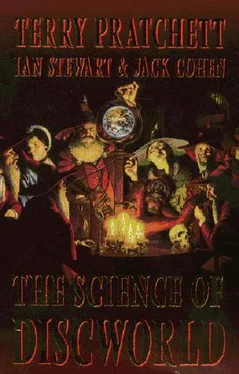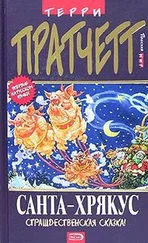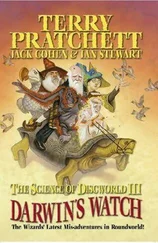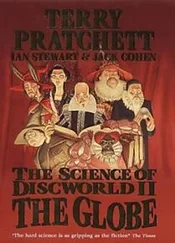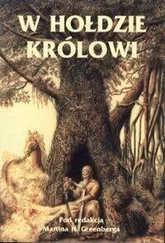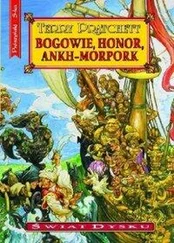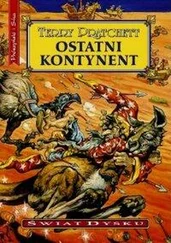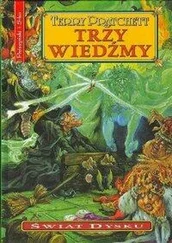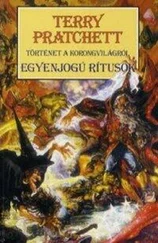Terry Pratchett - Science of Discworld
Здесь есть возможность читать онлайн «Terry Pratchett - Science of Discworld» весь текст электронной книги совершенно бесплатно (целиком полную версию без сокращений). В некоторых случаях можно слушать аудио, скачать через торрент в формате fb2 и присутствует краткое содержание. Жанр: Фантастика и фэнтези, на английском языке. Описание произведения, (предисловие) а так же отзывы посетителей доступны на портале библиотеки ЛибКат.
- Название:Science of Discworld
- Автор:
- Жанр:
- Год:неизвестен
- ISBN:нет данных
- Рейтинг книги:4 / 5. Голосов: 1
-
Избранное:Добавить в избранное
- Отзывы:
-
Ваша оценка:
- 80
- 1
- 2
- 3
- 4
- 5
Science of Discworld: краткое содержание, описание и аннотация
Предлагаем к чтению аннотацию, описание, краткое содержание или предисловие (зависит от того, что написал сам автор книги «Science of Discworld»). Если вы не нашли необходимую информацию о книге — напишите в комментариях, мы постараемся отыскать её.
Science of Discworld — читать онлайн бесплатно полную книгу (весь текст) целиком
Ниже представлен текст книги, разбитый по страницам. Система сохранения места последней прочитанной страницы, позволяет с удобством читать онлайн бесплатно книгу «Science of Discworld», без необходимости каждый раз заново искать на чём Вы остановились. Поставьте закладку, и сможете в любой момент перейти на страницу, на которой закончили чтение.
Интервал:
Закладка:
'That's right,' the Dean shouted. 'Turn it round! Use a stick if you have to!'
'What the thunder is going on here?' said Ricully.
'Look at them!' said the Dean, beside himself with rage. 'Backsliders! Caught them trying to return to the ocean!'
Ridcully glanced at one of the creatures, which was lying in the shallows and chewing on a crab.
'Didn't catch them soon enough, did you,' he said. 'They've got webbed paws.'
'There's been too much of this sort of thing lately!' snapped the Dean. He waved his finger at one of the creatures, who watched it carefully in case it turned out to be a fish.
'What would your ancestors say, my friend, if they saw you rushing into the water just because times are a bit tough on land?' he said.
'Er ... '"Welcome back"?' suggested Rincewind, trying to avoid the snapping jaws.
"Long time no sea'?' said the Senior Wrangler, cheerfully.
The creature begged, uncertainly.
'Oh, go on, if you must,' said the Dean. 'Fish, fish, fish ... you'll turn into a fish one of these days!'
'Y'know, going back to the sea might not be a bad idea,' said Ridcully, as they strolled away along the beach. 'Beaches are edges. You always get interestin' stuff on the edge. Look at those lizards we saw on the islands. Their world was all edges.'
'Yes, but giving up the land to just go swimming around in the water? I don't call that evolution.'
'But if you go on land where you have to grow a decent brain and some cunning and a bit of muscle in order to get anything done, and then you go back to see the sea where the fish have never had to think about anything very much, you could really, er, kick butt.'
'Do fish have...?'
'All right, all right. I meant, in a manner of speaking. It was just a thought, anyway.' Uncharacteristically, the Archchancellor frowned.
'Back to the sea,' he said. 'Well, you can't blame them.'
MAMMALS ON THE MAKE
AFTER THE DINOSAURS CAME THE MAMMALS -Not exactly.
Mammals constitute the most obvious class of animal alive on Earth today. When we say 'animal' in ordinary conversation, we're mostly referring to mammals, cats, dogs, elephants, cows, mice, rabbits, whatever. There are about 4,000 species of mammals, and they are astonishingly diverse in shape, size, and behaviour. The largest mammal, the blue whale, lives in the ocean and looks like a fish but isn't; it can weigh 150 tons (136,000 kg). The smallest mammals, various species of shrew, live in holes in the ground and weigh about an ounce (30 g). Roughly in the middle come humans which, paradoxically, have specialized in being generalists. We are the most intelligent of the mammals, sometimes.
The main distinguishing feature of mammals is that when they are young their mother feeds them on milk, produced by special glands. Other features that (nearly) all mammals have in common include their ears, specifically the three tiny bones in the middle ear known as the anvil, stirrup, and hammer, which send sound to the eardrum; hair (except on adult whales); and the diaphragm, which separates the heart and lungs from the rest of the internal organs. Virtually all mammals bear live young: the exceptions are the duckbilled platypus and the echidna, which lay eggs. Another curious feature is that mammalian red blood cells lack a nucleus, whereas the red cells of all other vertebrates possess a nucleus. All is this is evidence for a lengthy common evolutionary history, subject to a few unusual events of which the most significant was the early separation of Australia from the rest of Gondwanaland. Modern studies of mammalian DNA confirm that basically we are all one big happy family.
When the dinosaurs died out, the mammals had a field day. Released from dinosaurian thrall, they could occupy environmental niches that, only a few million years before, would merely have presented a dinosaur with an easy meal. It seems likely that the current diversity of mammals has a lot to do with the suddenness with which they came into their kingdom, for a while, almost any lifestyle was good enough to make a living. However, it would be wrong to imagine that the mammals came into existence to fill the gaps left by the vanished dinosaurs. Mammals had coexisted with dinosaurs for at least 150 million years.
Harry Jerison has suggested that before the dinosaurs became really dominant, many mammals were able to make their living in daylight, and they evolved good eyesight to do so. As the dinosaurs became a bigger and bigger problem, the mammals adopted a lower profile, mostly staying hidden undergound during the day. If you're a nocturnal animal, you rely on a really good sense of hearing, so evolutionary pressures then equipped the mammals with excellent ears, including those three little bones. However, they retained their eyesight. So when the mammals again dared to venture out into the daylight, they had good eyesight and good hearing. The combination gave them a substantial advantage over most remaining competitors.
Mammals evolved from an order of Triassic reptiles known as therapsids, small, quick-moving hunters, mostly, though some were herbivores. Compared to other reptiles, the therapsids were not especially impressive, but their low-profile lifestyle led, in stages, to the distinctive features of mammals. A diaphragm leads to more efficient breathing, useful if you need to run fast. It also lets the young animals continue to breathe while mother is feeding them her milk, changes to animals 'co-evolve' as a whole suite of cooperative attributes, not one at a time. Hair keeps you warm, and the warmer you are, the faster all your bodily parts can move ... and so on.
All this makes it difficult to decide when the mammal-like reptilian ancestors of the therapsids became reptile-like mammals ... but, as we've said, humans have problems with becomings. There was no such point: instead, there was a mostly gradual, but occasionally bumpy, transition. The earliest fossils that can definitely be identified as mammals come from 210 million years ago, creatures rejoicing in the name 'morganucodontids'. These were shrews, probably nocturnal, probably insect-eaters, probably egg-layers. Darwin's detractors objected to having apes as their ancestors: heaven knows what they would have thought about bug-eating egg-laying shrews. But there's good news too, if you're of that turn of mind, because morganucodontids were brainy. Not especially brainy for a shrew, but brainy compared to the reptiles from which they evolved. Admittedly, this was largely because the therapsids were as thick as two short ... er, slices of tree-fern, but it was a start.
How do we know that these early shrews were true mammals? One of the bits of an animal that survives as a fossil far more often than any other bit is the tooth. This is why palaeontologists use teeth, above all else, to identify species of long-dead animals. There are plenty of species for which the sole evidence is a tooth or two. Fortunately, you can tell a lot about an animal by its teeth. On the whole, the bigger the tooth is, the bigger the animal, an elephant's tooth today is a lot bigger than an entire mouse, so whatever animal it came from, it couldn't be mouse-sized. If you can find a jawbone, a whole array of teeth, all the better. The shape of a tooth tells us a lot about what the animal ate, grinding teeth are for plants, slicing teeth are for meat. The arrangement of teeth in a jawbone tells us a lot more. The morganucodontids made a major breakthrough in tooth design: teeth that interlocked when the jaws were brought together, very effective at cutting bits off meat or insects. They also paid a heavy price for their teeth, one that we still pay today. Reptiles continually produce new teeth: as old ones wear down, they get replaced. We produce just two set of teeth: milk teeth as children and the real thing as adults. When our adult teeth wear out, the only replacements available are artificial. Blame the morganucodontids for this: if you want to take advantage of precisely interlocking teeth, you have to maintain that precision, which is impractical if you keep discarding teeth and growing new ones. So they grew only two sets of teeth, and we have to do likewise.
Читать дальшеИнтервал:
Закладка:
Похожие книги на «Science of Discworld»
Представляем Вашему вниманию похожие книги на «Science of Discworld» списком для выбора. Мы отобрали схожую по названию и смыслу литературу в надежде предоставить читателям больше вариантов отыскать новые, интересные, ещё непрочитанные произведения.
Обсуждение, отзывы о книге «Science of Discworld» и просто собственные мнения читателей. Оставьте ваши комментарии, напишите, что Вы думаете о произведении, его смысле или главных героях. Укажите что конкретно понравилось, а что нет, и почему Вы так считаете.
